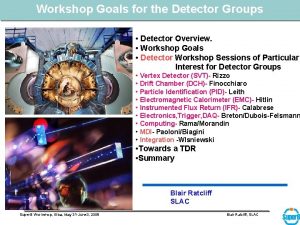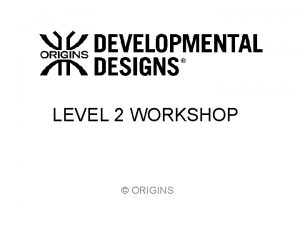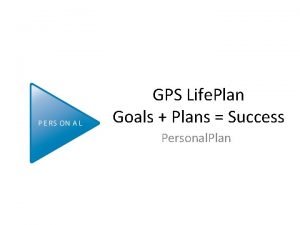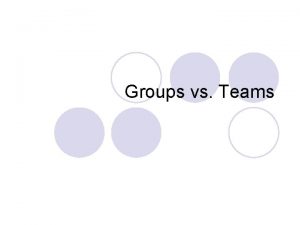Workshop Goals for the Detector Groups Detector Overview










- Slides: 10

Workshop Goals for the Detector Groups • Detector Overview. • Workshop Goals • Detector Workshop Sessions of Particular Interest for Detector Groups • Vertex Detector (SVT)- Rizzo • Drift Chamber (DCH)- Finocchiaro • Particle Identification (PID)- Leith • Electromagnetic Calorimeter (EMC)- Hitlin • Instrumented Flux Return (IFR)- Calabrese • Electronics, Trigger, DAQ- Breton/Dubois-Felsmann • Computing- Rama/Morandin • MDI- Paoloni/Biagini • Integration -WIsniewski • Towards a TDR • Summary Blair Ratcliff SLAC Super. B Workshop, Elba, May 31 -June 3, 2008 Blair Ratcliff, SLAC

Detector Overview ¡ Current B-Factory detectors have proven to be extremely effective instruments over the very broad physics program accessible at the U(4 S). l l l ¡ ¡ Two (+1) examples: Ba. Bar, Belle (Cleo-II). Serve as “world class prototypes” for Super. B! Optimized differently, but all were (are!) effective physics instruments. Comparisons between them help to define optimal strategies for subsystems in a Super. B detector. CDR detector design based on Ba. Bar (with reoptimization). Super. B machine acceptance limits similar to PEP-II: Ba. Bar’s geometry, field, and portions of several subsystems are rather close to optimal, Re-use of Ba. Bar gives excellent performance and saves money. Super. B Workshop, Elba, May 31 -June 3, 2008 2 Blair Ratcliff, SLAC

Directions for Detector Optimization ¡ From Machine and Environment: • Smaller Boost (7 x 4 Ge. V; bg=0. 28) Smaller radius beam-pipe to retain adequate vertex resolution. Larger barrel acceptance. More particles backward in detector with somewhat softer spectrum forward. • Some (though not all) components of machine background components will be substantially larger. Improve detector segmentation Improve detector speed Improve radiation hardness as needed. ¡ From physics goals, which emphasize rare decays, LFV in t physics, and recoil (n) physics l ¡ ¡ Would like best possible hermeticity, with good subsystem efficiency and performance. ~x 100 Luminosity Improved trigger, DAQ, & computing (~15 years later) Last, but not least, must replace aging components and technologies. Super. B Workshop, Elba, May 31 -June 3, 2008 3 Blair Ratcliff, SLAC

CDR Detector Layout – Based on Babar BASELINE New detector elements OPTION 4 Super. B Workshop, Elba, May 31 -June 3, 2008 Blair Ratcliff, SLAC

Detector Evolution-B Factory to Super. B Factory o With careful attention machine design and shielding in the IR, the backgrounds at a Super. B should be ~ to those we know (and love? ) at Ba. Bar An excellent Super. B detector is possible with ~ today’s technology l CDR Baseline based on Ba. Bar. It reuses ¡ ¡ ¡ Some elements have aged and need replacement. Others require moderate improvements to cope with the high luminosity environment, the smaller boost (4 x 7 Ge. V), and the high DAQ rates. l l l l l 5 Fused Silica bars of the DIRC & DCH Support Barrel EMC Cs. I(Tl) crystal and mechanical structure Superconducting coil & flux return (with some redesign). Small beam pipe technology Thin silicon pixel detector for layer 0, and a new 5 layer SVT? New DCH with CF mechanical structure, modified gas, cell size, cluster counting? New Photon detection for DIRC fused silica bars? Forward PID system (TOF in Baseline option) ? New Forward calorimeter crystals (LYSO? ). Backward EMC? Technology? Minos-style extruded scintillator for instrumented flux return Electronics and trigger- x 100 real event rate Computing- to handle massive date volume Super. B Workshop, Elba, May 31 -June 3, 2008 Blair Ratcliff, SLAC

Some Past Activities Towards the Super. B Detector 2007 ¡ March: CDR Published l Physics, Accelerator, Detector Nov 12 -13: Presentation to IRC. . . Will hear lots more about project status later today. 2008 ¡ Jan 7 -15: Physics retreat at Valencia ¡ Ongoing: ¡ (1) (2) General Detector meeting bi-weekly. Regular Sub-System and Computing Meetings (~ every one to two weeks) Feb 14 -16: Detector R&D workshop at SLAC ¡ May 31 st - June 3: Super. B Meeting in Elba ~2010. . . TDR Planning, Design, and R&D. ¡ Super. B Workshop, Elba, May 31 -June 3, 2008 Blair Ratcliff, SLAC

Examples of Kinds of Decisions needed for TDR Internal System versus General Detector Examples Internal: What is the SVT layer 0 technology? How is the beam pipe constructed? What is the technology for the backward EMC? What is the DCH cell configuration? DIRC Barrel SOB? General: Will there be forward PID in Super. B? What is the effect of material on EC EMC? What is the front end data volume? Where is the interaction point? Where do the in-detector electronics reside? Not always a clean separation, but general decisions will usually need an early resolution before the TDR. Some (not too many? ) internal subsystem choices could remain in TDR. Super. B Workshop, Elba, May 31 -June 3, 2008 Blair Ratcliff, SLAC

TDR Session (Tuesday Morning) For this discussion would like to ask each group to contribute a brief synopsis of their thoughts considering issues such as: What decisions must be taken before the TDR can be written? • What is the mechanism for reaching those decisions? How can missing information be obtained? • What simulation tools are needed? • What specific R&D is needed? • What detailed design is needed? When can it begin? • What are the time scales for the decisions. If options are open, how can they be resolved and on what time scale? • How many physicists are involved now ? How many are needed? When? • Support for R&D, technical and design personnel? • How does the subgroup interact with the other subgroups and incorporate general detector design considerations • Super. B Workshop, Elba, May 31 -June 3, 2008 Blair Ratcliff, SLAC

Parallel Detector Sessions at this Workshop Today for SVT, PID, EMC, DCH, IFR, & Computing ¡ Monday sessions on Detector optimization, benchmarking; simulation tools integration & transport; computing; electronics & trigger/DAQ; Geant 4 Session conveners: Please send me 1 -3 pages of highlights summarizing your sessions ASAP for my summary talk at the plenary session on Tues. ¡ Super. B Workshop, Elba, May 31 -June 3, 2008 Blair Ratcliff, SLAC

Summary § We have a sound conceptual design (presented in the Super. B CDR) for the Super. B detector, based on Ba. Bar. § Substantial Planning, Design, and Physics and Detector simulation studies are needed to develop the overall detector design. The individual Subsystems need R&D and appropriate software tools to develop the best detector components within this overall design. § We hope to move to a high quality technical design and TDR within the next 2 years. § Just getting started. Many opportunities to get (more? ) involved. 10 Super. B Workshop, Elba, May 31 -June 3, 2008 Blair Ratcliff, SLAC
 Strategic goals tactical goals operational goals
Strategic goals tactical goals operational goals Strategic goals tactical goals operational goals
Strategic goals tactical goals operational goals How are ethnic groups and religious groups related
How are ethnic groups and religious groups related Workshop goals examples
Workshop goals examples Workshop goals examples
Workshop goals examples Workshop goals examples
Workshop goals examples Success
Success General goals and specific goals
General goals and specific goals Examples of generic goals and product-specific goals
Examples of generic goals and product-specific goals Tack för att ni lyssnade
Tack för att ni lyssnade Debatt mall
Debatt mall



















